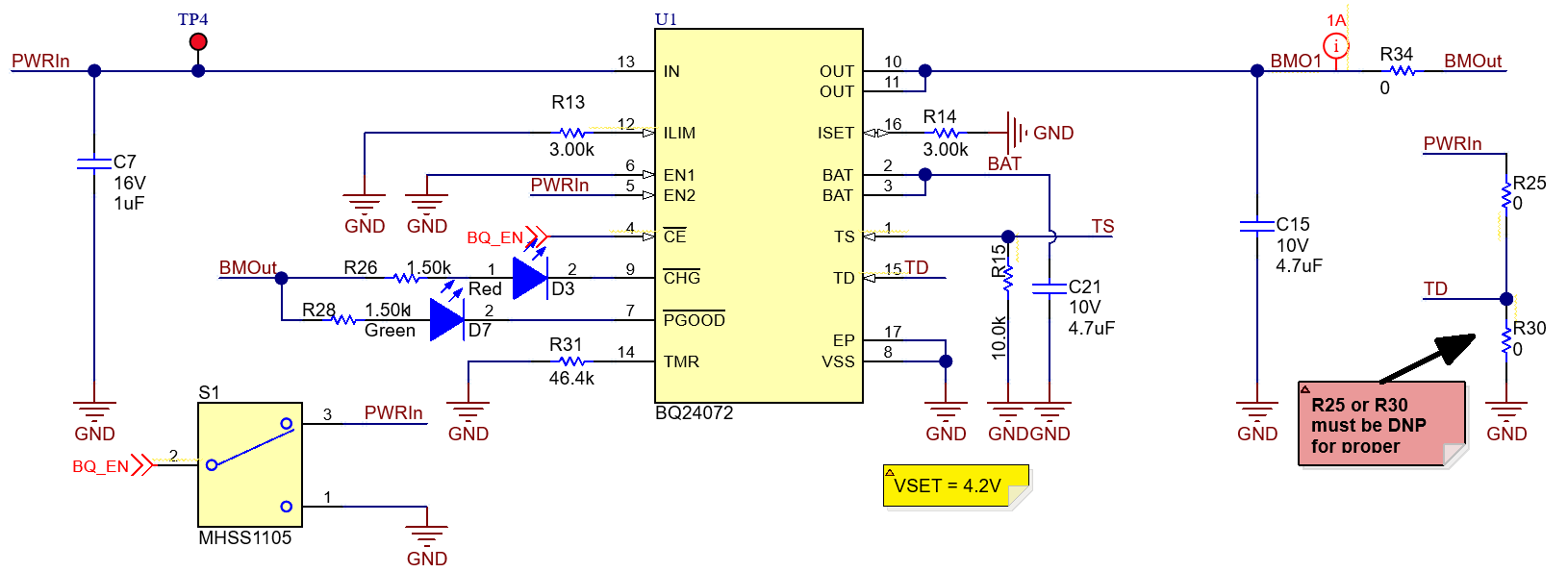TIDUF26 june 2023 BQ24072 , LMR36520 , TLV62568 , TPS2116
- 1
- Description
- Resources
- Features
- Applications
- 6
- 1System Description
- 2System Overview
-
3Hardware, Software, Testing Requirements,
and Test Results
- 3.1 Hardware Requirements
- 3.2 Test Setup
- 3.3 Test Results
- 4Design and Documentation Support
- 5About the Author
2.2.5 Battery Management
Battery charging and power path management are performed by the bq24072 in the TIDA-010932. The bq24072 provides a low-cost system that features independent battery charging and load paths through the power path capability without the need for any external FETs. The device can monitor battery temperature through a dedicated pin, provides USB-compliant inrush current and current limits, and provides PGOOD and charge signals.
The bq24072 is a single-power input device and was specifically chosen over dual-input devices due to cost. The bq24072 and ORing detailed in Section 2.2.4 provide the same functionality as a fully integrated dual-input device but at a lower cost. TIDA-010932 is designed with an understanding that end products can have different requirements and that ease of design changes to fit individual systems is necessary. If the end product does not use USB (or a secondary power source in general), the ORing remedy and the USB related components detailed in Section 2.2.2 can be eliminated and the single input of the bq24072 can be used for an even lower cost design. In such a scenario, a dual-input battery management IC is over-engineered for the application and incurs unnecessary costs or significant design changes. For those reasons, the bq24072 was chosen as the best low-cost design.
The bq24072 features power path capability, allowing the battery to supplement the main power source to meet high load demands. This feature allows the use of a smaller main power source, thus reducing costs further.
Figure 2-9 displays the setup and components chosen for the TIDA-010932. The bq24072 has a minimum recommended input voltage of 4.35 V, VOVP of 6.6 V, and a maximum absolute input voltage of 28 V. The device charges the battery up to 4.2 V (VBAT(REG)). The output is regulated to 200 mV above VBAT(REG).
 Figure 2-9 BQ24072 Circuit
Figure 2-9 BQ24072 CircuitA small input capacitor (C7) is chosen as USB 2.0 specifications require less than 10 μF to be hard started.
The bq24072 data sheet recommends between 1 μF and 10 μF of the input capacitance. A 4.7-μF battery input capacitor (C10) was chosen per data sheet recommendation. The output capacitor (C15) of 4.7 μF is the minimum recommended value per the data sheet.
To comply with USB 2.0 specifications, the input current must be limited to 500 mA. The EN1, EN2, and ILIM pins of the bq24072 allow a programmable current limit. As per the data sheet, EN1 is set HIGH and EN2 is set LOW to program a 500-mA current limit. ILIM must not be left floating, because doing so disables charging, so the ILIM is set to provide a higher current limit (536 mA) than the EN1 and EN2 pins, which allows the EN1 and EN2 current limit to be the dominant, more conservative limit. Equation 14 shows the calculation used in the TIDA-010932 for R13.
R14 is connected to the ISET pin and determines the fast charge current level of the battery (IO(CHG)) shown in Figure 2-9. The calculation for R14 in this reference design is shown in Equation 15. However, the fast charge current must be chosen depending on the battery specifications used in the end product.
Net TS is used to monitor the battery temperature on battery packs that have a built-in thermistor. If using TS, R15 must be not populated. Use R15 if leaving TS floating and not using temperature sensing. The value of 10k is per the data sheet recommendation.
Pin TD is tied to GND to enable charger termination, with the option to depopulate the path to ground and instead connect to PWRIn. Pin CE goes to a dip switch which allows the user to determine if the battery charging is active. PGOOD is pulled to BMOut when a valid input source is detected and is high impedance when the input power is not within specified limits. PGOOD can sink a maximum of 15 mA so R28 must be chosen appropriately to make sure PGOOD does not sink more than 15 mA. The TIDA-010932 uses an indication LED (D7) on the PGOOD pin.
Pin CHG is pulled to BMOUT when the battery is charging and is high impedance when the charging is complete or when the charger is disabled. R26 must be chosen to make sure CHG does not sink more than 15 mA. The TIDA-010932 uses an indication LED (D3) on the charge pin.